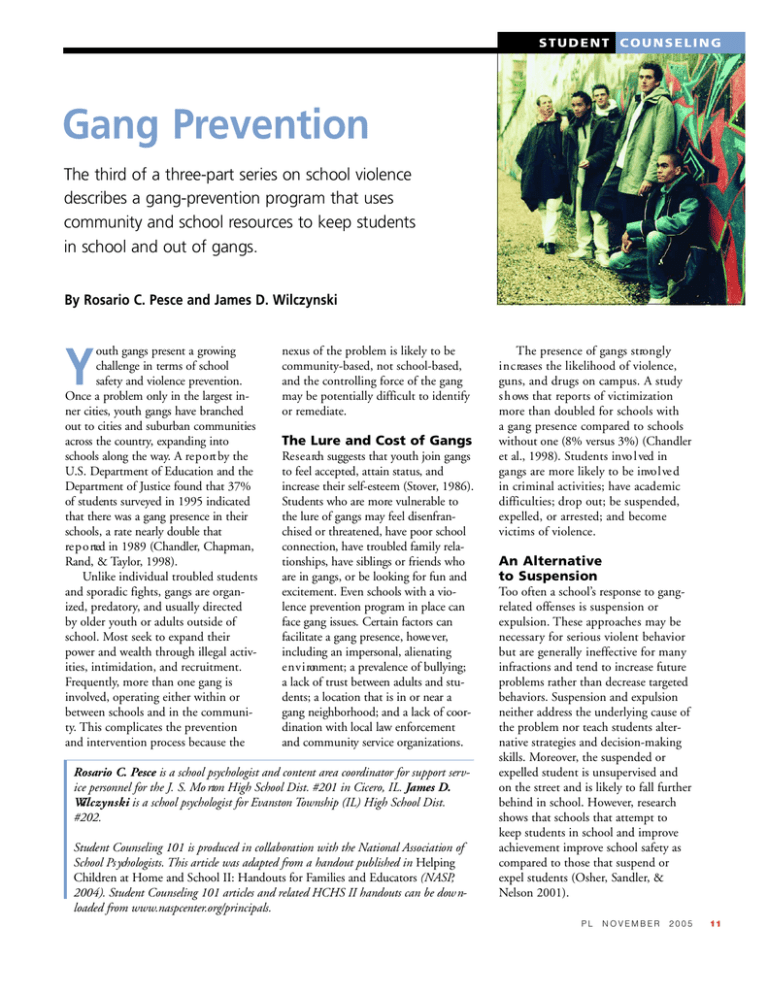Y
advertisement

STUDENT COUNSELING Gang Prevention The third of a three-part series on school violence describes a gang-prevention program that uses community and school resources to keep students in school and out of gangs. By Rosario C. Pesce and James D. Wilczynski Y outh gangs present a growing challenge in terms of school safety and violence prevention. Once a problem only in the largest inner cities, youth gangs have branched out to cities and suburban communities across the country, expanding into schools along the way. A re p o rt by the U.S. Department of Education and the Department of Justice found that 37% of students surveyed in 1995 indicated that there was a gang presence in their schools, a rate nearly double that re p o rted in 1989 (Chandler, Chapman, Rand, & Taylor, 1998). Unlike individual troubled students and sporadic fights, gangs are organized, predatory, and usually directed by older youth or adults outside of school. Most seek to expand their power and wealth through illegal activities, intimidation, and recruitment. Frequently, more than one gang is involved, operating either within or between schools and in the community. This complicates the prevention and intervention process because the nexus of the problem is likely to be community-based, not school-based, and the controlling force of the gang may be potentially difficult to identify or remediate. The Lure and Cost of Gangs Re s e a rch suggests that youth join gangs to feel accepted, attain status, and increase their self-esteem (Stover, 1986). Students who are more vulnerable to the lure of gangs may feel disenfranchised or threatened, have poor school connection, have troubled family relationships, have siblings or friends who are in gangs, or be looking for fun and excitement. Even schools with a violence prevention program in place can face gang issues. Certain factors can facilitate a gang presence, howe ver, including an impersonal, alienating e n v i ronment; a prevalence of bullying; a lack of trust between adults and students; a location that is in or near a gang neighborhood; and a lack of coordination with local law enforcement and community service organizations. Rosario C. Pesce is a school psychologist and content area coordinator for support service personnel for the J. S. Mo rton High School Dist. #201 in Cicero, IL. James D. Wilczynski is a school psychologist for Evanston Township (IL) High School Dist. #202. Student Counseling 101 is produced in collaboration with the National Association of School Ps ychologists. This article was adapted from a handout published in Helping Children at Home and School II: Handouts for Families and Educators (NASP, 2004). Student Counseling 101 articles and related HCHS II handouts can be dow nloaded from www.naspcenter.org/principals. The presence of gangs stro n g l y i n c reases the likelihood of violence, guns, and drugs on campus. A study s h ows that reports of victimization more than doubled for schools with a gang presence compared to schools without one (8% versus 3%) (Chandler et al., 1998). Students invo l ved in gangs are more likely to be invo l ve d in criminal activities; have academic difficulties; drop out; be suspended, expelled, or arrested; and become victims of violence. An Alternative to Suspension Too often a school’s response to gangrelated offenses is suspension or expulsion. These approaches may be necessary for serious violent behavior but are generally ineffective for many infractions and tend to increase future problems rather than decrease targeted behaviors. Suspension and expulsion neither address the underlying cause of the problem nor teach students alternative strategies and decision-making skills. Moreover, the suspended or expelled student is unsupervised and on the street and is likely to fall further behind in school. However, research shows that schools that attempt to keep students in school and improve achievement improve school safety as compared to those that suspend or expel students (Osher, Sandler, & Nelson 2001). PL NOVEMBER 2005 11 STUDENT COUNSELING Points to Consider H e re are some key points to consider when developing programs that are aimed at gang prevention in schools: ■ D o n ’t be afraid to ask, “Do we have a gang problem in our school?” A crisis does not have to occur before putting something in place. ■ Develop a working relationship with local law enforcement agencies. Police departments usually can provide re s o u rces to help schools determine the extent of the local gang presence and can help parents and staff members understand gang psychology. Basic understanding of signs, colors, clothing p a t t e rns, and so forth is important to minimize gang re p resentation on campus. ■ Conduct a needs assessment specifically geared toward gangs as part of your school safety team's efforts. Involve community partners throughout the assessment and planning. Identify and coordinate with cultural or faith leaders in the community about youth in gangs. If law enforcement agencies are not part of the team yet, this would be an excellent opportunity to include them. ■ Use in-school re s o u rces. Many staff members—such as deans of discipline, assistant principals, social workers, psychologists, counselors, and security staff members—may have already worked with gang-involved youth in one way or another. Use their experience in helping to develop, implement, and evaluate programming. ■ Data should drive decision making. Review what has worked and what has not. Obtain input from multiple sources in and outside of school. Use evidence-based interventions. Be flexible so you can make changes on the basis of results. Ensure that the interventions are culturally sensitive to the needs of the families your school serves. Gang Prevention in Schools Ef f e c t i ve gang prevention should be part of a larger school context that fosters a safe and healthy learning environment and should be closely integrated with community programs. Specifically, school-based programs need to have at least three important types of strategies: in-school safety and control procedures, in-school enrichment procedures that make school more meaningful and reduce feelings of alienation, and formal links to community-based serv i c e s (Goldstein & Kodluboy, 1998). Ef f o rts should be coordinated by the school safety team, and staff members should be trained to recognize the signs of gang involvement as well as local 12 PL NOVEMBER 2005 gang colors, dress codes, symbols, and the like. In addition, strategies should be tailored to reflect the needs and character of the school and the community, including sensitivity to the language and culture of the students being served. Three Tiers of Opportunity Pr i m a ry prevention programs involve all aspects of the school (e.g., curriculum, discipline, and adult and student attitudes) and develop and promote appropriate behavior and healthy emotional adjustment within the entire student body (Osher et al., 2001). Antibullying p rograms are an example of a primary pre vention program that can help reduce gang participation by creating a m o re positive school environment and reducing incidents of victimization and students’ subsequent desire to seek protection from the gang against the bully (Howell, 2000). Secondary prevention programs are aimed at students who are identified as at-risk for violence (Osher et al., 2001). One such program, CASASTART (Striving Together to Achieve Rew a rding To m o r rows), is geared toward children between the ages of 11 and 13 who come from “distressed” neighborhoods (Center for the Study and Prevention of Violence, 1999; Ha r rell, Cavanagh, & Sridharan, 1998). It is a multicontextual program that includes case management services, juvenile justice intervention, family services, mentoring, and community policing. Te rt i a ry interventions are intended for students who have engaged in some type of violent of behavior. The mosteffective tertiary programs involve individual behavioral and skills-building strategies, a strong family therapy component, and wraparound serv i c e s that address multiple needs (U.S. De p a rtment of Health and Human Se rvices, 2001). Schools can play an i m p o rtant role in all of these areas, including helping coordinate serv i c e s with other community agencies. Moving From Theory to Practice The GAIN (Gang Avoidance Initiative Now) program is an example of a tert ia ry alternative-to-suspension program for first-time in-school gang offenders. We participated in developing and implementing the program in response to a gang-related incident in October 1996 in which a former student shot a current student at a bus stop after school. The Chicago suburban high school district invo l ved is one of Illinois’ larger districts that, at the time, e n rolled close to 7,000 students on two campuses, over 38% of whom qualified for free and reduced-price school lunches. The program was funded in part through a Title IV, Safe and Drug Free Schools and Communities Grant. It is now in its ninth year and has prove n e f f e c t i veat improving outcomes for p a rticipating students. Community involvement and needs assessment. In response to a community meeting following the shooting, the school board developed a safe school plan that called for the formation of a violence prevention taskf o rce that met monthly and included all major stakeholders in the community. The group was cochaired by the principal and the city mayor and included representatives from state and local law e n f o rcement agencies; feeder school districts; county public health, mental health, and youth services; parks and recreation services; students and parents; and local business. The taskforce conducted a needs assessment to determine the availability of re l e vant community s e rvices and where the major gaps existed. Members agreed to develop an alternative to suspension program for firsttime in-school gang offenders. Developing the program. An interdisciplinary subgroup led by the school psychologist developed a curriculum that focused on building skills and developing trust and connection among students and adults. The program served as an alternative to suspension for such activities as fighting, throwing gang signs, and marking school or personal pro p e rty with gang symbols; it was not a substitute for expulsion for serious violations. Eligible students and their parents could opt to be part of the p rogram after signing a contract with the dean of discipline. The GAIN curriculum. The original five lesson plans expanded to nine lessons with input from students who went through the first year of the program. Topics include: • Getting off to a good start • Second chances • Drugs, alcohol, and violence • Juvenile law and dru g s • Juvenile law and bodily injury • Conflict resolution • Family and peers • Getting out • Developing a life plan. The program also includes two field trips: one off-campus trip to a rehabilitation hospital and another in-school presentation by correctional officers and prisoners from a federal correctional institution. The field trips and lessons help illustrate the consequences of continued gang-related behavior and the benefits of dropping out of a gang. Students learn problem-solving and relationship-building skills as well as how to leave a gang behind. Staff members do not try to force students to leave their gangs but convey that they respect students’ right to make that decision for themselves in due time. They also help students develop a life plan to give them goals outside of gang involvement. Team-teaching appro a c h . Classes are taught by one of several adults— such as school-based police officers, support service personnel, and counselors—who are present for eve ry lesson even when they are not teaching. This creates a sense of continuity for the students. Former gang members assist in teaching two lessons and go on both field trips. GAIN classes are like any other as far as rules and expectations, are limited to 15 students each semester, and meet once a week during the school day for nine weeks. The low student-teacher ratio encourages substantive discussion and fosters re l a t i o nship building and eventual trust. Graduation. To support students’ sense of accomplishment for completing the program, the school sponsors a graduation ceremony that is hosted by a community partner. Community agencies that are committed to working with families and gang issues are invited to speak about their services during the brief ceremony, which includes interpreters for non-English speaking families. Mingling time is built into the event for informal networking between families and the agencies. Resources Drug Prevention and School Safety Program Coordinators w w w. k 1 2 c o o rdinator.org This Web site contains 15 free online training modules dealing with school safety and violence prevention for school personnel, including a module on gang pre v e ntion titled “Youth Gangs: Going Beyond the Myths to Address a Critical Pro b l e m ” (www.k12coordinator.org/onlinece/onlineevents/gangs_event/index.htm). Youth Gang Programs and Strategies w w w. n c j rs.org/pdffiles1/ojjdp/171154.pdf Published by the U.S. Office of Juvenile Justice and Delinquency Prevention, this document summarizes more than 50 years of gang program evaluations as well as information concerning gangs, interventions, and specific school-based pro g r a m s and contact information. JUSTINFO w w w. n c j rs.org/ This biweekly electronic newsletter is created by the National Criminal Justice Reference System (NCJRS) and is administered by the U.S. Department of Justice. JUSTINFO highlights information from NCJRS-sponsoring agencies and includes funding and grant information that is available for specific target populations. PL NOVEMBER 2005 13 STUDENT COUNSELING Moving on. GAIN graduates are invited to attend a weekly “aftercare” group during the school day one period a week. This group is lead by the GAIN facilitators, usually school support service personnel, and students can remain members for as long as they wish throughout their school care e r. In addition, when funds allow for it, GAIN graduates are paired through a mentoring program with school staff members and meet weekly inside of school to monitor how the student is doing Signs of Gang Involvement The Kansas City, MO, Department Gang Squad has provided the following list of w a rning signs of gang membership: ■ Changes in the child's behavior ■ Not associating with long-time friends and being secretive about new friends and activities ■ Changes in hair or dress style or having a group of friends who have the same hair or dress style ■ Changes in normal routines with new friends, such as not coming home after school or staying out late at night with no explanation ■ Suspected drug or alcohol use, including inhalants ■ Unexplained material possessions, such as expensive clothing, jewelry, or money ■ The presence of firearms, ammunition, or other deadly weapons ■ Change in attitude about school, church, or other normal activities ■ Discipline problems at school, church, or attended functions ■ Lower grades at school or skipping school ■ Change in behavior at home—increases in confrontational behavior, such as talking back, verbal abuse, name calling, and a disrespect for parental authority ■ A new fear of police ■ Phone threats to the family from rival gangs (or unknown callers) directed against your child ■ Photographs of the child and others displaying gang hand signs, weapons, cash, drugs, or gang-type clothing ■ Graffiti on or around the child’s locker or at home, including drawings and doodling of gang-related figures, themes of violence, or gang symbolisms ■ Physical signs of being in a fight, such as bruises and cuts and secrecy on the child's part as to how they were received ■ A newfound sense of bravery—bragging that he or she is too tough to be “messed” with ■ A new nickname ■ A newfound sympathy or defense of gang activity by the child ■ Tattoos or “branding” with gang-related symbols. Source: Youth Gangs: Going Beyond the Myths to Address a Critical Problem, online training event, U.S. Department of Education Office of Safe and Drug Free Schools, www.k12coordinator.org 14 PL N OVEMBE R 2005 with the life plan he or she deve loped during the class. Evaluation and outcomes. Formative evaluation was used in the first few years of the program to make modifications to the lessons by asking students what they learned foll owing each weekly lesson. Qu a l i t a t i ve evaluation is done on an ongoing basis through exit interviews at the end of each nine-week session. The interview includes questions re g a rding expectations about the pro g r a m , comments about continued contact with gangs, views on who students can approach about gang issues, ideas for future topics, and a rating of each lesson. Qu a n t i t a t i ve evaluation occurs regularly through experimental and control comparison studies that look at staying in school, getting good grades, and exhibiting positive behavior. GAIN graduates are compare d with like offenders who did not participate in the program. Results fro m the three studies conducted thus far consistently show that GAIN graduates stay in school and graduate at higher rates than students in the control group of gang offenders who did not participate. Context Is Key Essential to the success of gang prevention and intervention is that it is an integral part of a comprehensive plan that is aimed at preventing violence and fostering a safe learning environment for all students. As seen with GAIN, community collaboration is a necessary ingredient as well. The GAIN task force has continued to drive subsequent initiatives as well as enable us to seek out and win grant funding to support and expand the program. PL The GAIN curriculum can be obtained by e-mailing Rosario Pesce at vppsych@aol.com. R e f e rences ❏ Center for the Study and Pre vention of Violence. (1999). Blueprints promising p ro g rams fact sheet: CASASTART. Boulder, CO: Un i versity of Colorado at Boulder, Institute of Behavioral Science, Center for the Study and Pre vention of Violence. ❏ Chandler, K. A., Chapman, C. D., Rand, M. R., & Taylor, B. M. (1998). Student re p o rts of school crime: 1989 and 1995. Washington, D.C.: U.S. De p a rtment of Justice, Office of Justice Programs, Bu reau of Justice St a t i s t i c s , and U.S. De p a rtment of Education, National Center for Educational St a t i s t i c s . ❏ Goldstein, A. P., & Ko d l u b oy, D. W. (1998). Gangs in schools: Si g n s , symbols, and solutions. Champaign, IL: Re s e a rch Pre s s . ❏ Ha r rell, A. V., Cavanagh, S., & Sr i dharan, S. (1998). Impact of the children at risk pro g ram: Compre h e n s i ve final re p o rt II. Washington, DC: The Urban Institute. ❏ Howell, J. C. (2000). Youth gang p ro g rams and strategies: OJJDP summary. Washington, DC: U.S. De p a rtment of Justice, Office of Justice Programs, Office of Ju venile Justice and Delinquency Prevention. ❏ Osher, D. M., Sandler, S., & Nelson, C. L. (2001). The best approach to safety is to fix schools and support children and staff. In R. J. Skiba & G. G. Noam (Eds.), Ze ro tolerance: Ca n suspension and expulsion keep schools safe? New directions for youth development, No. 92 ( p p. 127–154). San Fr a n c i s c o : Jo s e y - Ba s s . ❏ St over, D. (1986, August). Ga n g s . American School Board Jo u rnal, 1 9–24. ❏ U.S. De p a rtment of Health and Human Services. (2001). Youth violence: A re p o rt of the surgeon genera l . Rockville, MD: U.S. De p a rtment of Health and Human Services, Centers for Di s e a s e C o n t rol and Pre vention, National Center for In j u ry Pre vention and Control, Su bstance Abuse and Mental Health Se rvices Administration, Center for Me n t a l Health Se rvices, and National Institutes of Health, National Institute of Me n t a l He a l t h . Advertisement PL NOVEMBER 2005 15





